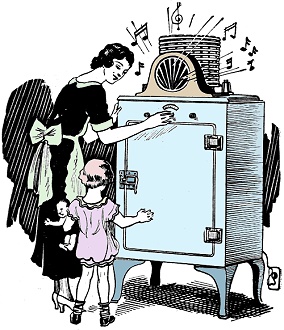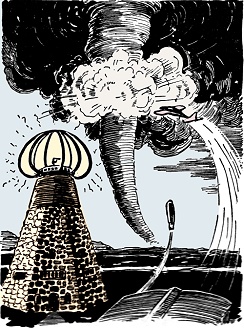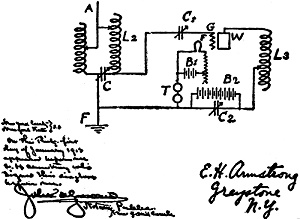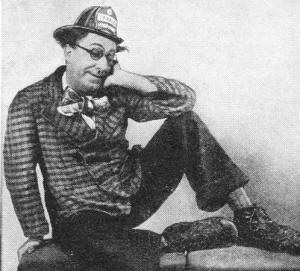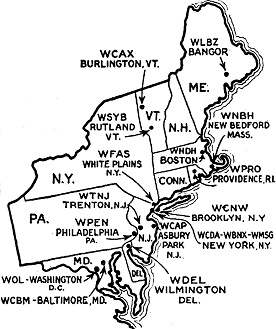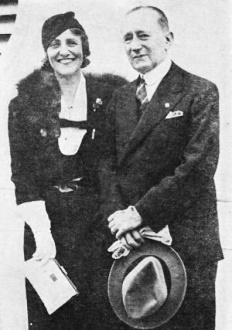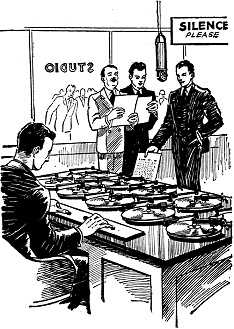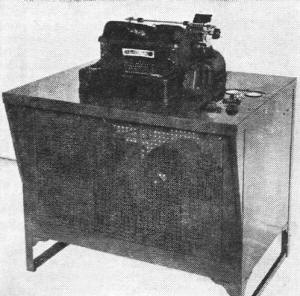The Radio Month in Review
|
|
When the concept of radio refrigerators was presented in a 1933 edition of Radio-News magazine, it was not quite what has become reality today. At the time, the Radio Electrical Exposition had recently been held in Madison Square Garden and the world was just getting used to the miracle of radio waves - and refrigerators for that matter. Radio-refrigerators never did make their way into the consumer market. Fast-forward 80 years and now we're seeing the advent of radio-refrigerators re-emerge, only in a completely different format. This time, rather than playing shows from local commercial broadcast stations, these appliances are communicating with Wi-Fi routers to allow owners to check on status and contents from remote locations. In other news, the editors report on a scheme to use a remote-controlled airplane, signaled by a Tesla spark gap transmitter, to drop bombs inside tornados in order to break up and stop their destructive presence (that drawing of a low-wing, single-engine monoplane that looks a lot like a Piper Cherokee, was way ahead of its time). There is also a photo of Major Armstrong's original lab notebook sketch of his idea for a regenerative receiver circuit. It is usually very worthwhile to have a look back in time to see what was developing and being foreseen. The Radio Month in ReviewNo, gentle reader, this combination radio refrigerator was not at the 1933 Radio Show. It may be there next year. Radio is now such a vast and diversified art it has become necessary to make a general survey of important monthly developments throughout the field. Radio-Craft analyzes these developments, and presents here a review of those items which are of interest to all. New York Radio Show The Radio Electrical Exposition in Madison Square Garden came to an auspicious ending on Saturday, September 30th, after having run for ten days, Sunday included. The show was a great success, it is claimed by the exhibitors, because more than 200,000 passed through its gates. According to the management, the show drew over $1,500,000 in business for the exhibitors, and they are so heartened that they will run another show in 1934, to be held September 19th to 29th. Loitering around the show, the editor tripped over dozens of refrigerators in his search for radio sets. It was a grand show for refrigerators and, once in a while, he could discern in the offing some radio sets. The only thing that was missing was a combination refrigerator and radio. The whole ground floor was at least 80% refrigerators, with 20% radio sets thrown in for good measure. This should not be considered a harsh criticism of the show, because it was not a Radio Show primarily, for the pure, unadulterated radio shows of former years had blown up; and the depression made it necessary to combine radio and electricity, which the exposition did successfully. As far as we could find out, not a radio parts manufacturer was represented. Tesla radio-controlled airplanes will bomb tornadoes out of business. Armstrong's original regenerative sketch, invented in 1913. Ed Wynn the actor - and No. 3 Broadcast Chain originator. Territory embraced by the Amalgamated Broadcast System. Senatore Marchese Guglielmo Marconi and his wife as they appeared
on landing in New York. The new Broadcast Noise Robot creates anything from the roar of 10,000 baseball fans to the crash of two automobiles. The new Radio Typewriter now ready for the market. News and static are equally enjoyed by it. Tesla Tames Tornadoes And now comes the veteran 79-year-old scientist, Nikola Tesla, the world's greatest living inventor, who says that he has found means to tame the tornado, which annually takes toll of thousands of human lives, not to speak of the millions of dollars of property damage. Paying a visit to Hugo Gernsback, editor of this publication, the other day, Dr. Tesla disclosed his plan which, by the way, is published with a great many Illustrations along with his original article, in the December issue of Every-Day Science and Mechanics magazine. Tall, gaunt, and sparse, the ascetic great inventor retains a keen interest in applied science. His recommendation, in a few words. is to use radio-controlled robot airplanes, which can be controlled from the ground. The airplane is sent up and directed straight toward the funnel of the tornado as soon as one is reported. Should a tornado start at sea, the same thing can be accomplished by Government patrol ships, which will dispatch radio-controlled robot airplanes tornadoward. The trick, according to Dr. Tesla, is to drop a huge charge of explosives right into the mouth of the tornado funnel. This is to be accomplished by distant watchers, who spot the airplane when it is directly above the funnel and release by radio impulse an explosive charge which, dropping into the funnel, destroys the whirling vacuum of the tornado and stops its progress before further damage can be done . Armstrong Regenerated Every radio fan worth his salt knows what regeneration means. It means additional power, more sensitivity, to radio sets. Short-wave fans, particularly, cannot do without regeneration. But who is the inventor of regeneration? Last month, the now totally bald, but youngish looking Edwin H. Armstrong walked in on the editor of this publication. For the first time in 12 years he smiled. For the first time in a dozen years he consented to talk about a sacred and taboo subject - Regeneration. Reason: there has been a 12-year battle about it between Dr. Lee deForest, the inventor of the 3-element vacuum tube and Major Edwin H. Armstrong. Recently, the U. S. Court of Appeals for the Second Circuit handed down its verdict, making Armstrong* the sole and undisputed inventor of regeneration. Armstrong showed that he first invented regeneration in the year 1913, and he conclusively seems to prove now, that he and not deForest is the real inventor. Of course, the Supreme Court has not as yet rendered its verdict, and on the other hand, the controversy may never go to the Supreme Court. The radio fraternity will now arise en masse and shout congratulations. *The decision was rendered in favor of the Radio Engineering Laboratories, Inc. against the Radio Corp. of America. A. T. & T. Co., and de Forest Radio Co. Ed Wynn Chain a Dud With a great amount of fanfare and noise throughout the daily press, and colorful noises at the headquarters of the newly-born Amalgamated Broadcasting System, the newest national broadcasting chain made its debut on September 25th. It is Ed Wynn's long-heralded "third chain." Most of the noise was made on the 11th floor of the vast A.B.S. quarters at Madison Ave. and 52nd St., New York. We say most of the noise and hullabaloo was in the broadcasting offices; because very little of the noise percolated into the ears of the chain's prospective listeners. We expect a real broadcasting chain to have millions of listeners, into whose ears the noise, or sound, will finally settle. Alas and alack, the new A.B.S. chain is not destined to do so. The reason is that the chain is a chain in name only, and, from what we can see, it will never amount to much for some very simple and elementary reasons. All of the stations, with the exception of two, are in trade parlance so-called "graveyard" stations; that is, they are so far down in the broadcasting spectrum, that broadcast listeners are unlikely to tune in any of them, even though Ed Wynn himself were to broadcast all day long - which he probably won't. Not only are all of the stations except two - WHDH, Boston and WLBZ Bangor - down in the graveyard, but they have no power either. All of them put together don't come anywhere near having half of the power of one such station as WABC, WJZ, WEAF or WLW. Most of these stations cannot be heard for more than 25 miles, if so far; and in congested districts like New York, Philadelphia and Washington, these "repeaters" on out of town station wavelengths can be heard only a few blocks. Heterodyning, they have birdy whistles, or a program of unintelligible hash. The idea of a third chain is O.K. if the promoters had the stations; unfortunately, the chain has no stations to amount to anything and, when they talk of a "national outlet," as their high-pressure advertising department no doubt will, it will be found that the outlet is not functioning. The only people who will listen to the emissions will be the advertisers; and, in our opinion, as former owners of a fairly decent broadcast station, the advertisers will not get results. With no exception the A.B.S. goes to the identical cities now adequately served by National Broadcasting Co. and Columbia, where both veteran chains control good station outlets. A.B.S. covers no new territory, no new towns, performs no discernible service. The new chain does not use American Telephone and Telegraph Co.'s 'phone lines to link together its out of town radio stations; instead it uses Western Union wire lines. Broadcasters have tried this cheaper method time and again, but have found out that they are noisy and can't be properly balanced. Broadcast engineers in the know never use them except in dire emergency. If the third chain is simply a scheme to sell stock, it may succeed in this, but the poor investors will be stuck, as usual. We have all sorts of respect for Mr. Ed Wynn as a comedian but, as a broadcaster, we believe he has pulled a serious boner, and has been deluded by promoters. Stations of the Amalgamated Chain Marconi in the United States Marconi returned to the United States, last month, on a special invitation to the Century of Progress in (Chicago. Senatore, now the Marchese (Marquis) Guglielmo Marconi and the Marchesa Marconi arrived at New York on the Italian liner Conte di Savoia on September 28th. Piloted by David Sarnoff, head of the Radio Corporation of America, to the new Radio City, just opened, Marconi had to run the gauntlet of some twenty-odd radio scribes who corralled him in one of the rooms in Radio City and lambasted him with radio questions, mostly foolish. Marconi graciously let it be known that he came to the United States "to learn something about wireless." Sarnoff disputed this point of the illustrious one-eyed inventor by .stating that "no one in the United States can teach Marconi anything about wireless." After having divested himself in good humor of the radio reporters, Marconi was taken to the roof of Radio City, where he was duly photographed - returning to the Ritz-Carlton Hotel later, where he spent the night. He then embarked for Chicago, where he arrived on October 2nd. Here, a great tribute was paid to Marconi, as the father of radio, at a luncheon given in his honor at the Museum of Science and Industry. From this he rose, at Mr. Roosevelt's invitation, to greet the President, with whom he was photographed. Subsequently, returning to his own luncheon, he said: "The money aspect of the development of radio must not be forgotten. For example, my first experiment in broadcasting across the Atlantic cost more than $200.00." In concluding the ceremonies, Rufus Dawes, president of the exposition, presented a special medal to Senatore Marconi at the Century of Progress; while a light-beam from the star Capella, picked up by a telescope in Florence, Italy, and sent by radio and telegraph to Chicago, switched on the floodlights of the Fair. The inventor then flashed around the world, by wireless, the letter "S," which thirty years ago he sent so dramatically across the Atlantic. Silent Bedlam A tremendous crash is heard, the grinding of metal upon metal, splintering of glass, the screams of the heroine; then, the siren of the traffic cops, the roar of hundreds of actual voices of the dear populace. Shots are fired at the hit-and-run driver responsible for the crash. These are the noises that issue forth from your loudspeaker, as you sit in your study and listen to the latest radio presentation. Vaguely, you picture in your mind's eye a large room in which all these noises are manufactured, with hundreds of people being employed to bring it all about. You are due for a disappointment; because, the next time, if you have a friend at one of the key stations of a large broadcasting net, you may step into the studio where all the noise originates, and you will find that here "bedlam reigns" silently. Everything is very prosaic, and at the most there are only three or four people in the studio, speaking in moderately low voices. Where, then, is all the noise coming from? If you look closer, you will see a long table with about ten phonograph turntables; one operator sits in front of them. The turntables are all rotating. The operator merely depresses a push-button, which brings the phonograph pickup down on a precise spot of a certain phonograph record when the cue is given. This one phonograph record may give the exact reproduction of the automobile crash, Depressing the next button, the pickup descends upon the spot which unloosens pistol shots. The next will give a marvelous reproduction of a roaring crowd. Meanwhile, the operator who pushes the buttons does nothing but wear a pair of phones and listen to the output of the phonograph discs. You see, all the pieces have been recorded from actual crashes, actual crowds, actual shots, etc. When required, an impresario simply orders whatever "noises" he wants; this is much simpler, much less costly, and the noises can be used at any time later on. This new scheme has been developed into perfection by the Camden, N. J., plant of the Radio Corporation of America, and is now in use. The ease with which the sound effects can be injected into the program by this method is just one more example of the remarkable development of broadcasting in the past few years. Radio Typewriters Once upon a time, you used to send out-of-town messages by the dot-and-dash method, as practiced by Western Union. Last year, the great and powerful American Telephone & Telegraph Company perfected their "Teletype" machines, which they rent to you. Owning the wire system themselves, they rent you the Teletype machine, which is nothing but a typewriter, to which a telegraphic transmitter has been attached, and a similar machine is placed in your Chicago office for the paltry sum of $1.20 for 3 minutes and 40¢ for each additional minute. A New York merchant can now send all the messages he wants to his Chicago office, day after day. He couldn't afford to do that by sending straight messages by Western Union or Postal Telegraph. Not to be outdone in this line of endeavor, and to make the operation still cheaper, a number of radio enthusiasts have been working on the radio typewriter for years. Clyde Fitch, well known to readers of Radio-Craft, and inventor of the Tropadyne radio circuit, has been active in the development of radio typewriters; and last month Radio Industries started manufacturing them in a Binghamton, N. Y. plant. The chief outlet at the present time is the U. S. Army and Navy. It is expected that large factories, brokers, etc., will use the radio typewriter presently. Mr. Fitch recently demonstrated it in New York, where it was operated between uptown and downtown offices on 5 meters, and worked to a charm. It seems to be foolproof with the exception of one old bugaboo - and that is static. Old Man Static, when he gets going, is liable to print some letters that were not intended originally; but, unless the static is exceedingly bad, it doesn't make much difference, because you can easily spot the incorrect letters. Anyhow, even ordinary wire telegrams contain misspellings traceable not to static but to clerical mistakes.
Posted November 29, 2023 |
|

